Recent Development of High-Energy Short-Pulse Lasers with Cryogenically Cooled Yb:YAG
Abstract
:1. Introduction
2. Changes in Crystal Properties with Temperature
2.1. Thermodynamic Properties
2.2. Spectral Properties
3. Suppression of ASE Effect
4. Cryogenically Cooled Yb:YAG Lasers
4.1. High-Energy Nanosecond Laser
4.2. High-Energy Picosecond Laser
5. Discussion
Author Contributions
Funding
Institutional Review Board Statement
Informed Consent Statement
Data Availability Statement
Conflicts of Interest
References
- Johnson, L.F.; Geusic, J.E.; Uitert, L.V. Coherent oscillations from tm3+, ho3+, yb3+ and er3+ ions in yttrium aluminum garnet. Appl. Phys. Lett. 1965, 7, 127–129. [Google Scholar] [CrossRef]
- Wang, X.D. Research on Diode Pumped Thin Disk Laser. Master’s Thesis, Changchun University of Science And Technology, Changchun, China, December 2015. [Google Scholar]
- Wang, S.Q.; Li, Y.L.; Li, S.M.; Bai, C.C.; Wang, Y.B.; Lei, Y. Research progress of LD pumped Yb:YAG solid-state laser. Jiguang Yu Hongwai 2018, 48, 3–9. [Google Scholar]
- Fan, T.Y. Heat generation in Nd:YAG and Yb:YAG. IEEE J. Quantum Electron. 1993, 29, 1457–1459. [Google Scholar] [CrossRef]
- Wang, P.F.; Zhang, D.; Lv, B.D. Recent advances of diode-pumped thin disc-laser. Jiguang Jishu 2003, 6, 551–553+566. [Google Scholar]
- Chenais, S.; Druon, F.; Forget, S.; Balembois, F.; Georges, P. On thermal effects in solid state lasers: The case of ytterbium-doped materials. Prog. Quantum Electron. 2009, 30, 89–153. [Google Scholar] [CrossRef] [Green Version]
- Zhang, Z.H.; Zhang, H.A. The relationship between the energy relaxation time and fluorescence radiation lifetime in three level system. Guangpuxue Yu Guangpu Fenxi 1989, 4, 1–4. [Google Scholar]
- Yan, X.W.; Jiang, X.Y.; Wang, Z.G.; Zheng, J.G.; Li, M.; Xiao, K.B. Cryogenic liquid-cooled Yb:YAG bulk amplifier. Zhongguo Jiguang 2019, 46, 59–64. [Google Scholar]
- Wang, X.D.; Gao, L.L.; Li, G. Research on characteristics of all-solid-state Yb:YAG disk laser. Ke Ji Feng 2015, 23, 3–4. [Google Scholar]
- Fan, T.Y.; Ripin, D.J.; Aggarwal, R.L.; Ochoa, J.R. Cryogenic Yb3+-doped solid-state lasers. IEEE J. Sel. Top. Quantum Electron. 2007, 13, 448–459. [Google Scholar] [CrossRef]
- Aggarwal, R.L.; Ripin, D.J.; Ochoa, J.R.; Fan, T.Y. Measurement of thermo-optic properties of Y3Al5O12, Lu3Al5O12, YAIO3, LiYF4, LiLuF4, BaY2F8, KGd(WO4)2, and KY(WO4)2 laser crystals in the 80–300 K temperature range. J. Appl. Phys. 2005, 98, 200. [Google Scholar] [CrossRef]
- Brown, D.C. The promise of cryogenic solid-state lasers. IEEE J. Sel. Top. Quantum Electron. 2005, 11, 587–599. [Google Scholar] [CrossRef]
- Koechner, W.; Sun, W. Solid-State Laser Engineering, 1st ed.; Science Press: Beijing, China, 2022; pp. 356–405. [Google Scholar]
- Wu, W.M.; Wu, H.Y.; Xu, X.J.; Guo, S.F. Cryogenically Cooled High Average Power Yb:YAG Laser. Jiguang Yu Guangdianzixuejinzhan 2010, 47, 42–47. [Google Scholar]
- Dong, J.; Bass, M.; Mao, Y. Dependence of the Yb3+ emission cross section and lifetime on temperature and concentration in yttrium aluminum garnet. J. Opt. Soc. Am. B 2003, 20, 1975–1979. [Google Scholar] [CrossRef]
- Peterson, P.; Gavrielides, A.; Newell, T.C.; Vretenar, N.; Latham, W.P. ASE in thin disk lasers: Theory and experiment. Opt. Express 2011, 19, 25672–25684. [Google Scholar] [CrossRef] [PubMed]
- Hua, S.; Wang, X.J. Amplified spontaneous emission in thin-disk lasers. In Solid State Lasers XXI: Technology and Devices; SPIE: Bellingham, WA, USA, 2012; pp. 370–377. [Google Scholar]
- Antognini, A.; Schuhmann, K.; Amaro, F.; Biraben, F.; Dax, A.; Giesen, A. Thin-Disk Yb:YAG Oscillator-Amplifier Laser, ASE, and Effective Yb:YAG Lifetime. IEEE J. Quantum Electron. 2009, 45, 993–1005. [Google Scholar] [CrossRef]
- Li, L.; Wang, J.L.; Cheng, X.J.; Liu, J.; Shi, X.C.; Chen, W.B. Cryogenic Yb:YAG solid state pulsed laser amplifier. Hongwai Yu Jiguagngongcheng 2013, 42, 1170–1173. [Google Scholar]
- Wang, M.Z.; Duan, W.T.; Cao, D.X.; Zheng, J.G.; Jiang, X.Y.; Li, M.Z.; Tan, J.C.; Yu, H.W.; Jing, F. Laser diode pumped cryogenically cooled Yb:YAG laser design for rep-rated high-energy output. Qiangjiguang Yu Lizishu 2010, 22, 36–40. [Google Scholar]
- Fu, X.; Liu, T.H.; Lei, X.X.; Liu, Q. High energy diode-pumped rep-rated nanosecond solid-state laser. Zhongguo Jiguang 2021, 48, 45–65. [Google Scholar]
- Wang, M. Recent Progress of Laser Diode-Pumped Solid-State Laser Drivers for Inertial Fusion Energy. Jiguang Yu Guangdianzixuejinzhan 2008, 45, 56–63. [Google Scholar]
- Drake, R.P. A journey through high-energy-density physics. Nucl. Fusion 2019, 59, 035001. [Google Scholar] [CrossRef]
- Perry, M.D.; Sefcik, J.A.; Cowan, T.; Hatchett, S.; Hunt, A.; Moran, M.; Pennington, D.; Snavely, R.; Wilks, S.C. Hard X-ray production from high intensity laser solid interactions (invited). Rev. Sci. Instrum. 1999, 70, 265–269. [Google Scholar] [CrossRef]
- Mason, P.; Martin, D.; Ertel, K.; Jan, P.; Butcher, T.; Martin, H. Kilowatt average power 100 J-level diode pumped solid state laser. Optica 2017, 4, 438–439. [Google Scholar] [CrossRef]
- Novo, T.; Albach, D.; Vincent, B. From 10 to 30 joules with the Lucia laser system: Update on current performance and cryogenic amplifier development. In Proceedings of the 2013 Conference on Lasers and Electro-optics (CLEO), San Jose, CA, USA, 9–14 June 2013. [Google Scholar]
- Bayramian, A.; Armstrong, J.; Beer, G. High-average-power femto-petawatt laser pumped by the Mercury laser facility. J. Opt. Soc. Am. B 2008, 25, B57–B61. [Google Scholar] [CrossRef]
- Korn, G.; Silva, L.O.; Haefner, C.L. High average power, diode pumped petawatt laser systems: A new generation of lasers enabling precision science and commercial applications. Proc. SPIE 2017, 10241, 1024102. [Google Scholar]
- Ogino, J.; Tokita, S.; Kitajima, S.; Yoshida, H.; Kawanaka, J. 10 J operation of conductive-cooled Yb:YAG active-mirror amplifier and prospects for 100 Hz operation. Opt. Lett. 2020, 46, 621–624. [Google Scholar] [CrossRef]
- Yasuhara, R.; Kawashima, T.; Sekine, T. 213 W average power of 2.4 GW pulsed thermally controlled Nd:glass zigzag slab laser with a stimulated Brillouin scattering mirror. Opt. Lett. 2009, 33, 1711–1713. [Google Scholar] [CrossRef]
- Sekine, T.; Kurita, T.; Kurata, M. Development of a 100-J DPSSL as a laser processing platform in the TACMI consortium. High Energy Density Phys. 2020, 36, 100800. [Google Scholar] [CrossRef]
- Liu, T.H.; Feng, T.; Sui, Z.; Liu, Q.; Gong, M.L.; Zhang, L.; Jiang, B.X.; Fu, X. 50 mm-aperture Nd:LuAG ceramic nanosecond laser amplifier producing 10 J at 10 Hz. Opt. Express 2019, 27, 15595–15603. [Google Scholar] [CrossRef]
- Jiang, X.; Wang, Z.; Yan, X. LD end-pumped 12J-10Hz Nd:YAG pulse laser. Proc. SPIE 2019, 11333, 113330M. [Google Scholar]
- Fan, Z.W.; Qiu, J.S.; Kang, Z.J.; Chen, Y.Z.; Tang, X.X. High beam quality 5 J, 200 Hz Nd:YAG laser system. Light Sci. Appl. 2017, 6, e17004. [Google Scholar] [CrossRef] [Green Version]
- Kurata, M.; Sekine, T.; Hatano, Y.; Muramatsu, Y.; Kawanaka, J. Development of a 100 J Class Cryogenically Cooled Multi-disk Yb:YAG Ceramics Laser. In Advanced Solid State Lasers; Optical Society of America: Washington, DC, USA, 2019. [Google Scholar]
- Banerjee, S.; Ertel, K.; Mason, P.D. DiPOLE: A 10 J, 10 Hz cryogenic gas cooled multi-slab nanosecond Yb:YAG laser. Opt. Express 2015, 23, 19542–19551. [Google Scholar] [CrossRef] [PubMed]
- Mason, P.D.; Banerjee, S.; Ertel, K. DiPOLE100: A 100 J, 10 Hz DPSSL using cryogenic gas cooled Yb:YAG multi slab amplifier technology. In High-Power, High-Energy, and High-Intensity Laser Technology II; International Society for Optics and Photonics: Bellingham, WA, USA, 2015. [Google Scholar]
- Mason, P.D.; Banerjee, S.; Smith, J. Development of a 100 J, 10 Hz laser for compression experiments at the High Energy Density instrument at the European XFEL. High Power Laser Sci. Eng. 2018, 6, e65. [Google Scholar] [CrossRef] [Green Version]
- Reagan, B.A.; Berrill, M.; Wernsing, K.A. High-average-power, 100-Hz-repetition-rate, tabletop soft-x-ray lasers at sub-15-nm wavelengths. Phys. Rev. A 2014, 89, 381–397. [Google Scholar] [CrossRef] [Green Version]
- Salehi, F.; Goers, A.J.; Hine, G.A. MeV electron acceleration at 1 kHz with <10 mJ laser pulses. Opt. Lett. 2016, 42, 215–218. [Google Scholar] [CrossRef] [PubMed]
- Hollinger, R.; Bargsten, C.; Shlyaptsev, V.N. Efficient picosecond x-ray pulse generation from plasmas in the radiation dominated regime. Optica 2017, 4, 1344. [Google Scholar] [CrossRef]
- Reagan, B.A.; Wernsing, K.A.; Curtis, A.H. Demonstration of a 100 Hz repetition rate gain-saturated diode-pumped table-top soft X-ray laser. Opt. Lett. 2012, 37, 3624–3626. [Google Scholar] [CrossRef] [Green Version]
- Braun, A.; Korn, G.; Liu, X.; Du, D.; Mourou, G. Self-channeling of high-peak-power femtosecond laser pulses in air. Opt. Lett. 1995, 20, 73–75. [Google Scholar] [CrossRef]
- Rohwetter, P.; Kasparian, J.; Stelmaszczyk, K. Laser-induced water condensation in air. Nat. Photonics 2010, 4, 254–270. [Google Scholar] [CrossRef]
- Kasparian, J.; Rodriguez, M.; Mejean, G.; Yu, J.; Salmon, E.; Wille, H. White-light filaments for atmospheric analysis. Science 2003, 301, 61–64. [Google Scholar] [CrossRef]
- Schimmel, G.; Produit, T.; Mongin, D.; Kasparian, J.; Wolf, J.P. Free space laser telecommunication through fog. Optica 2018, 5, 1338. [Google Scholar] [CrossRef]
- Uchida, S.; Shigeaki, Y.; Shimada, H. Laser-triggered lightning in field experiments. J. Opt. Technol. 1999, 66, 199. [Google Scholar] [CrossRef]
- Herkommer, C.; Krtz, P.; Jung, R.; Klingebiel, S.; Metzger, T. Ultrafast thin-disk multipass amplifier with 720 mJ operating at kilohertz repetition rate for applications in atmospheric research. Opt. Express 2020, 28, 30164–30173. [Google Scholar] [CrossRef] [PubMed]
- Baumgarten, C.; Pedicone, M.; Bravo, H.; Wang, H.; Reagan, B.A. 1 J, 0.5 kHz repetition rate picosecond laser. Opt. Lett. 2016, 41, 3339–3342. [Google Scholar] [CrossRef] [PubMed]
- Areagan, B.; Baumgarten, C.; Jankowska, E. Scaling diode-pumped, high energy picosecond lasers to kilowatt average powers. High Power Laser Sci. Eng. 2018, 6, e11. [Google Scholar] [CrossRef] [Green Version]
- Zapata, L.E.; Schweisthal, S. Joule-Class 500 Hz Cryogenic Yb: YAG Chirped Pulse Amplifier. In Proceedings of the 2019 Conference on Lasers and Electro-Optics (CLEO), San Jose, CA, USA, 1 July 2019. [Google Scholar]
- Wang, Y.; Chi, H.; Baumgarten, C. 1.1 J Yb:YAG Picosecond Laser at 1 kHz Repetition Rate. Opt. Lett. 2020, 45, 6615–6618. [Google Scholar] [CrossRef] [PubMed]
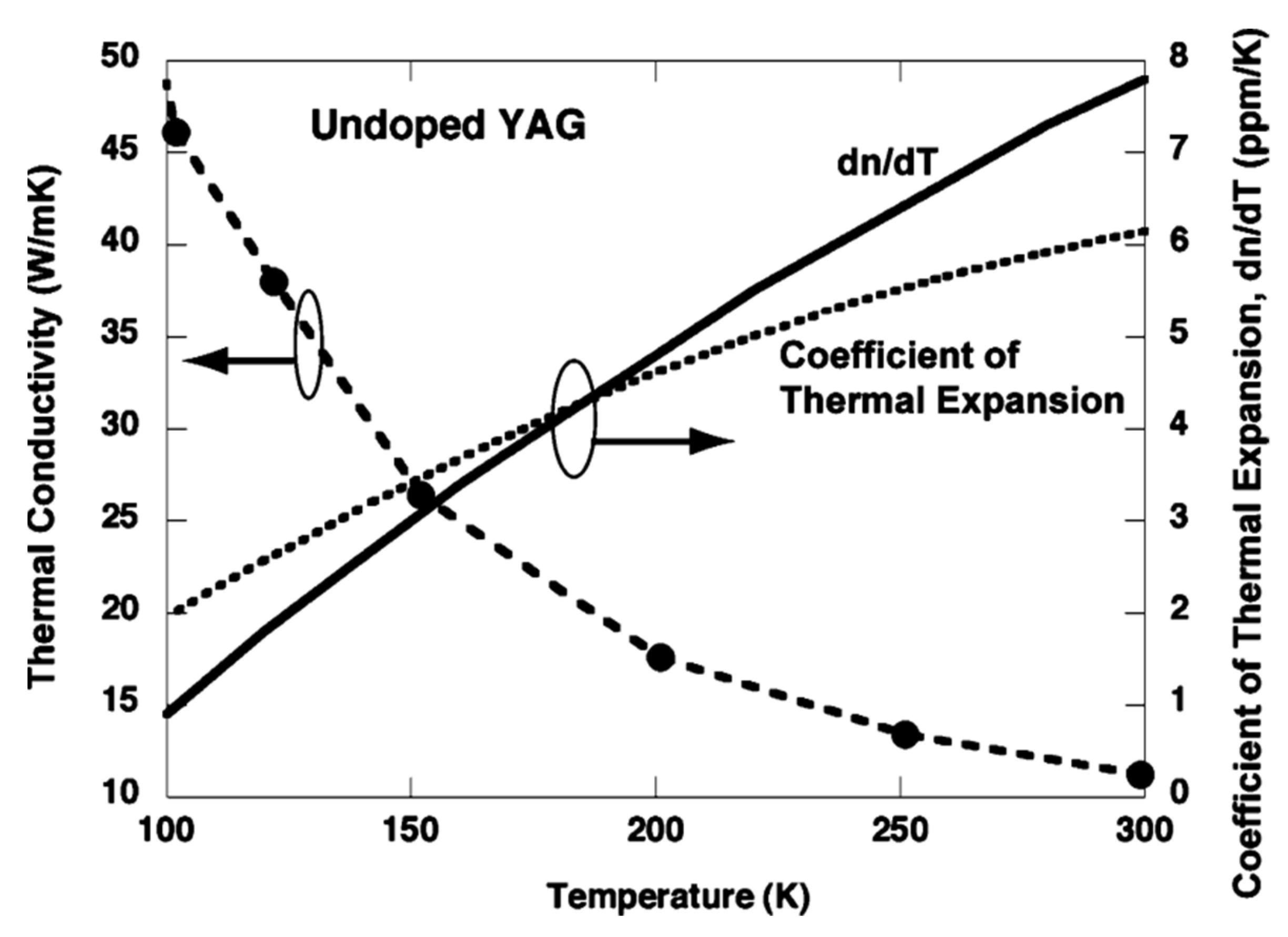
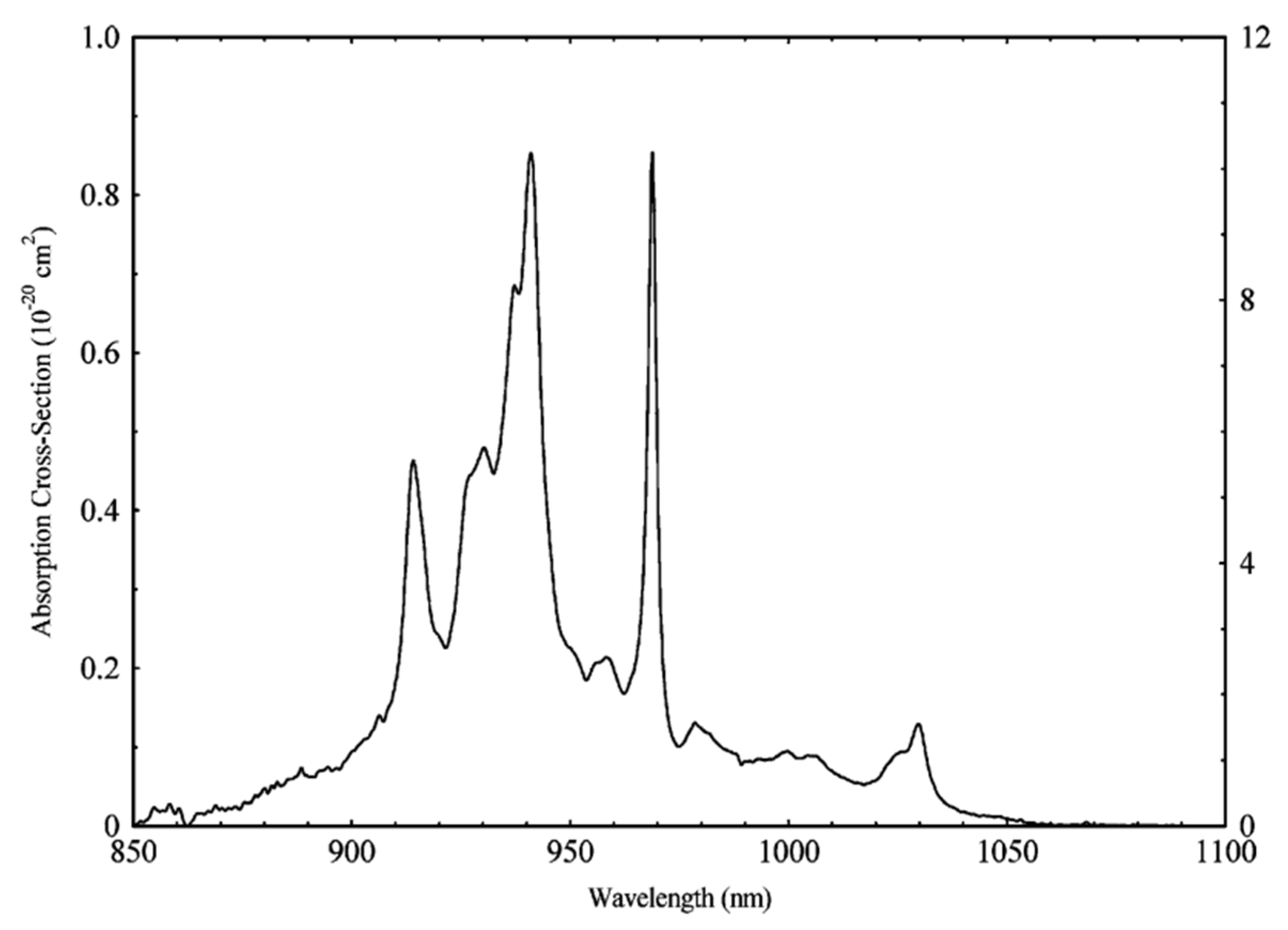
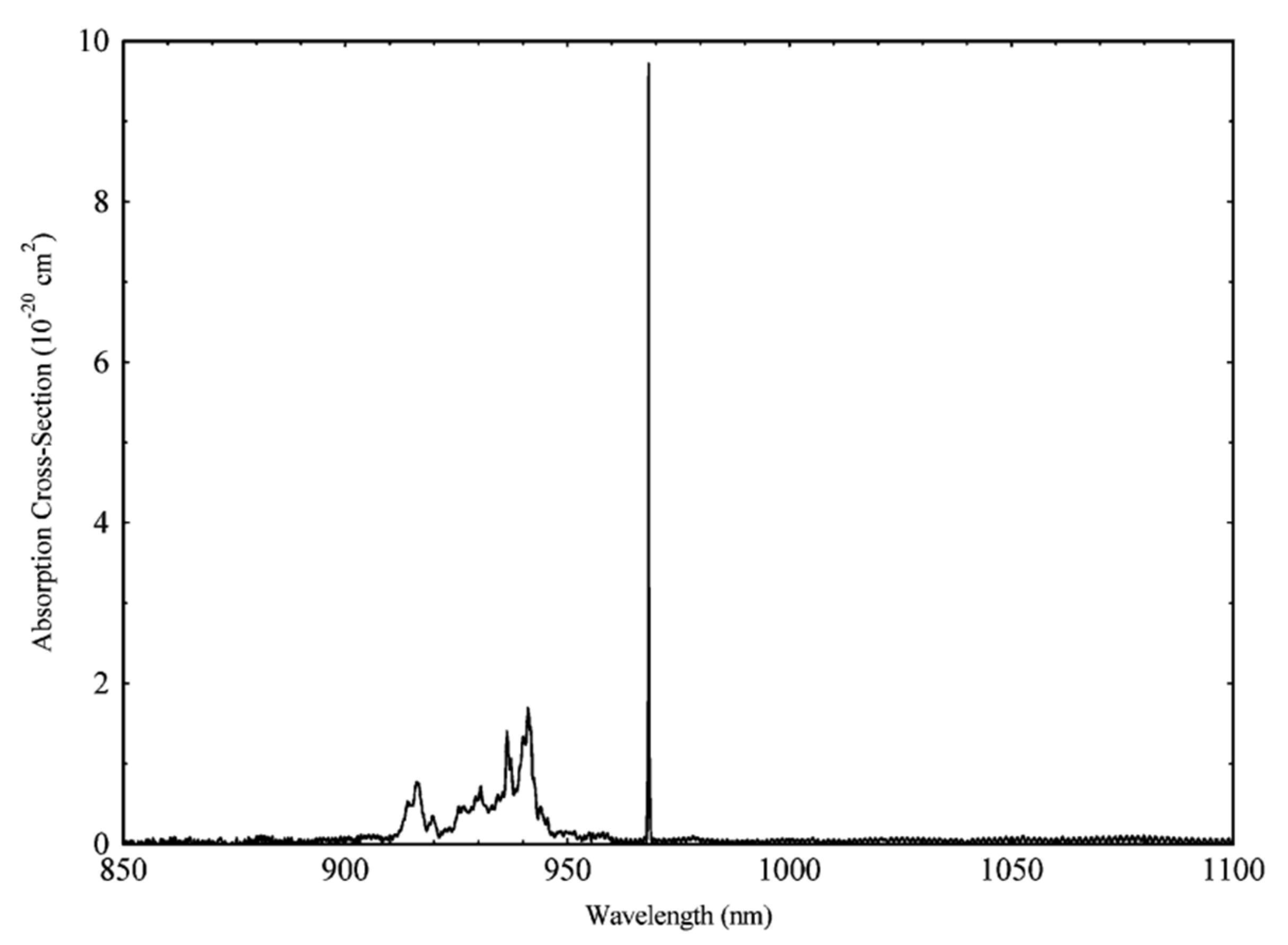
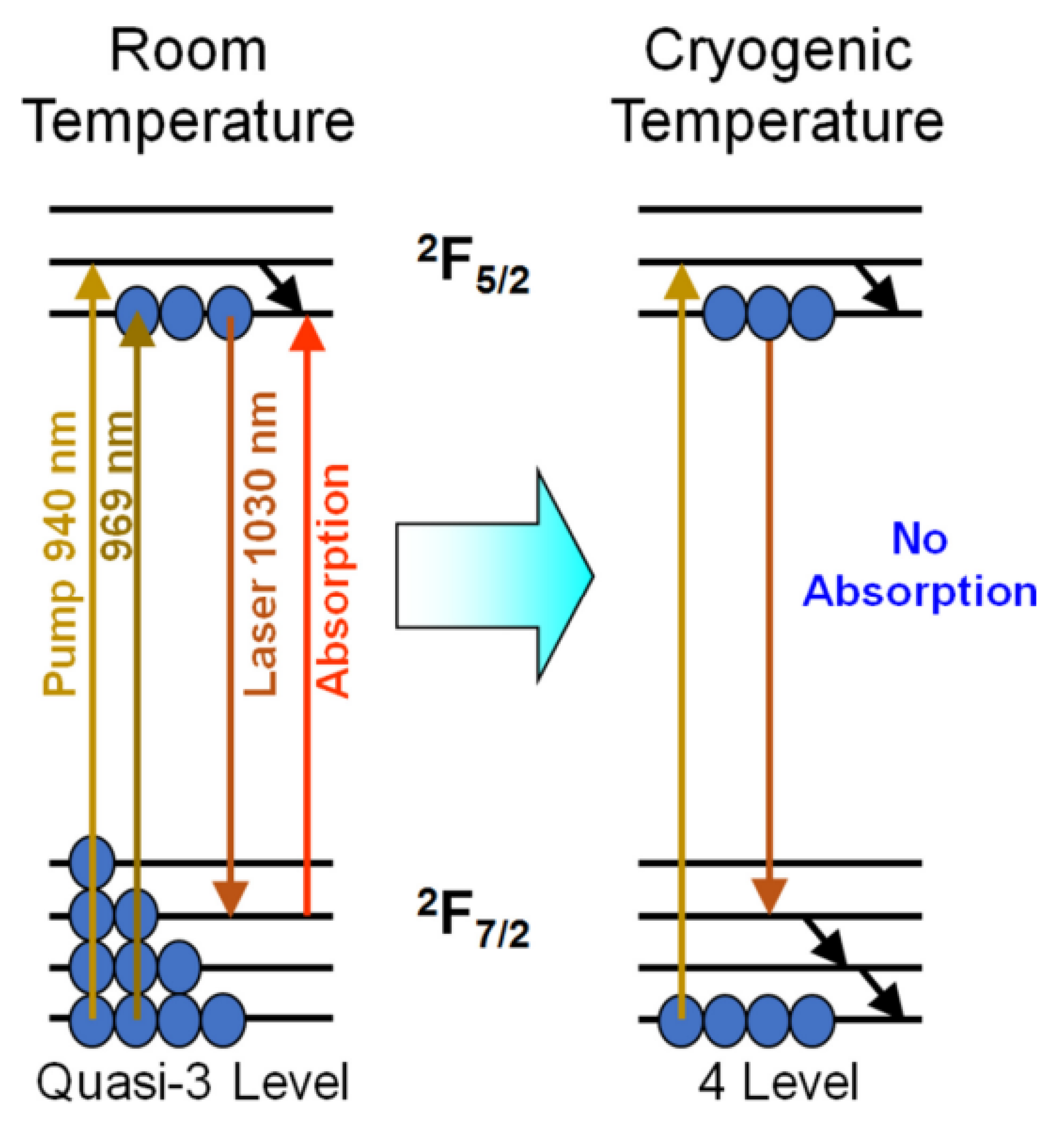
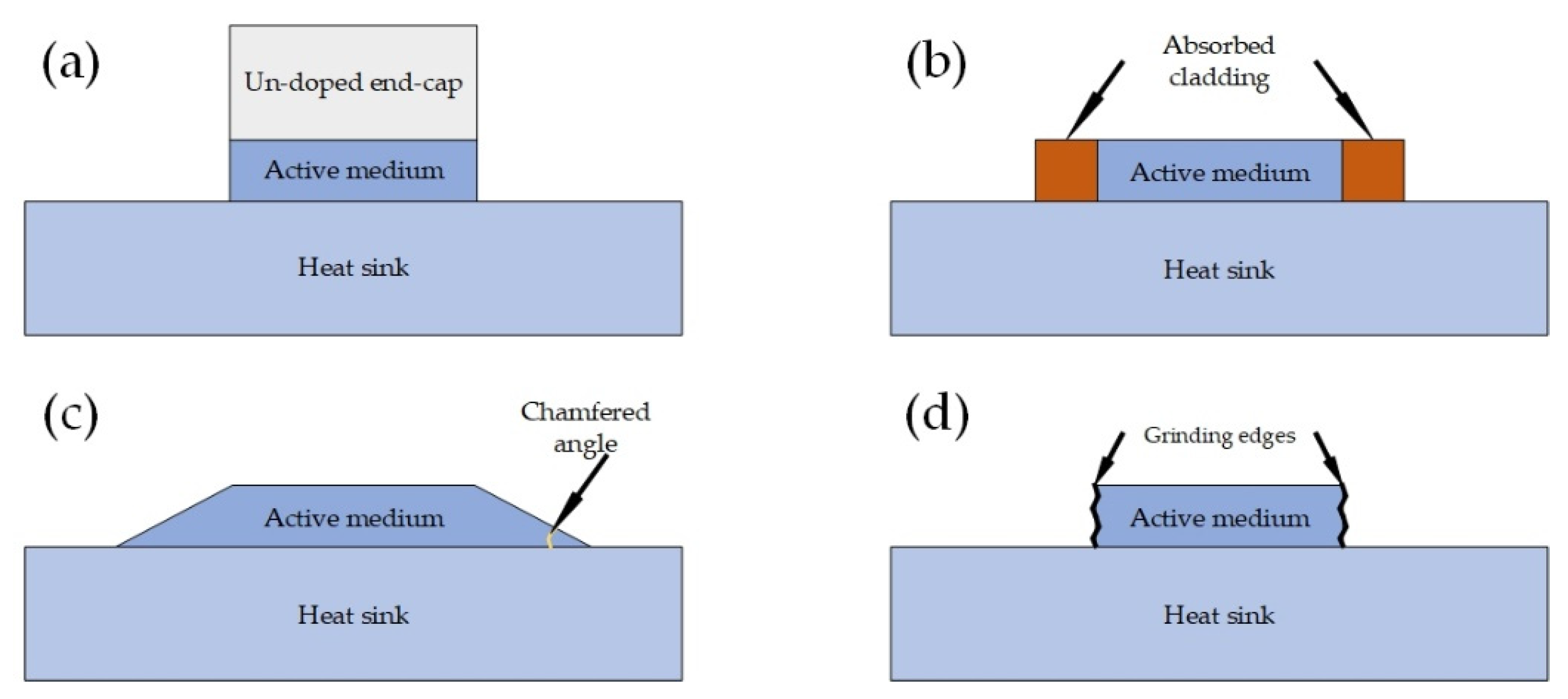

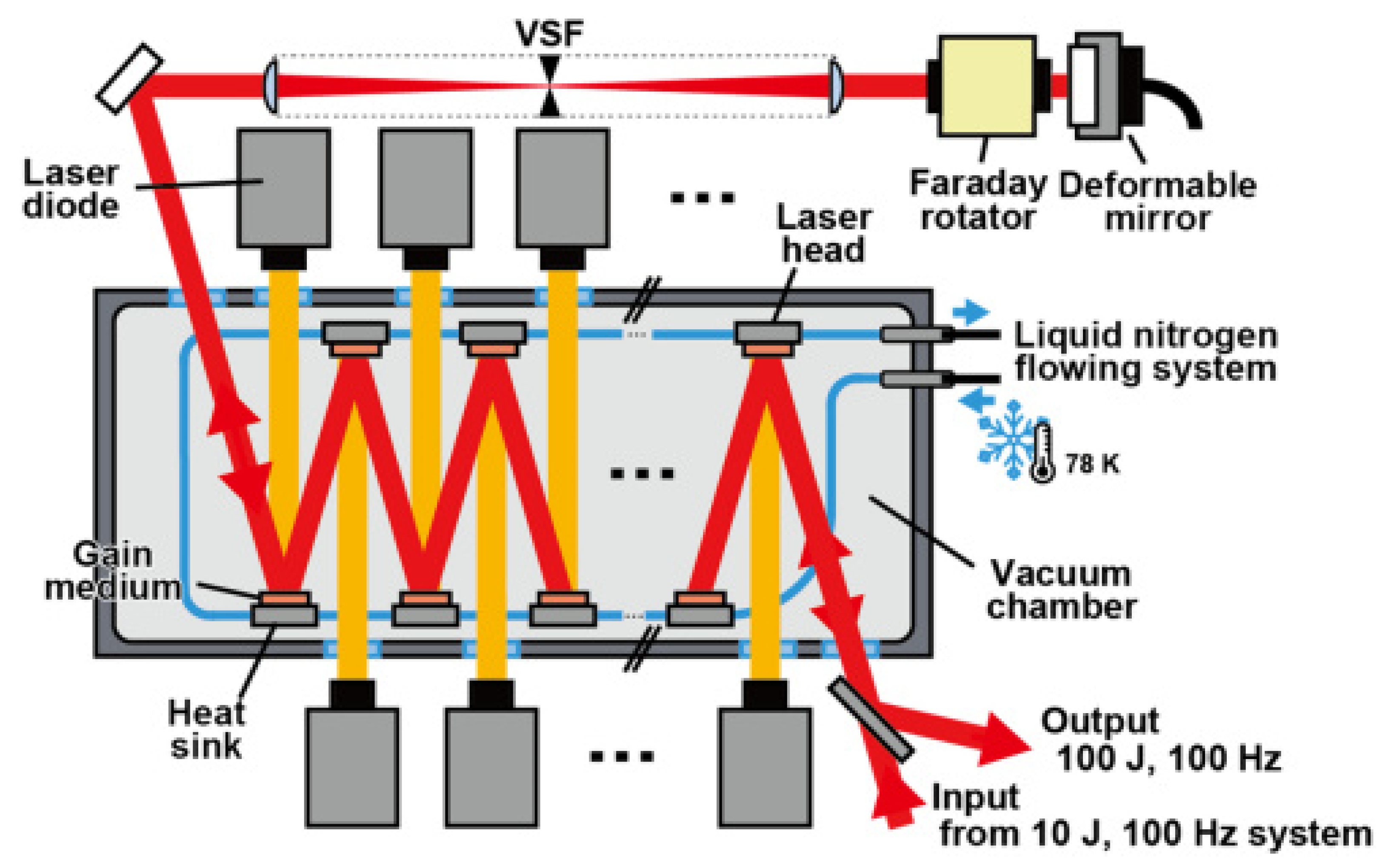
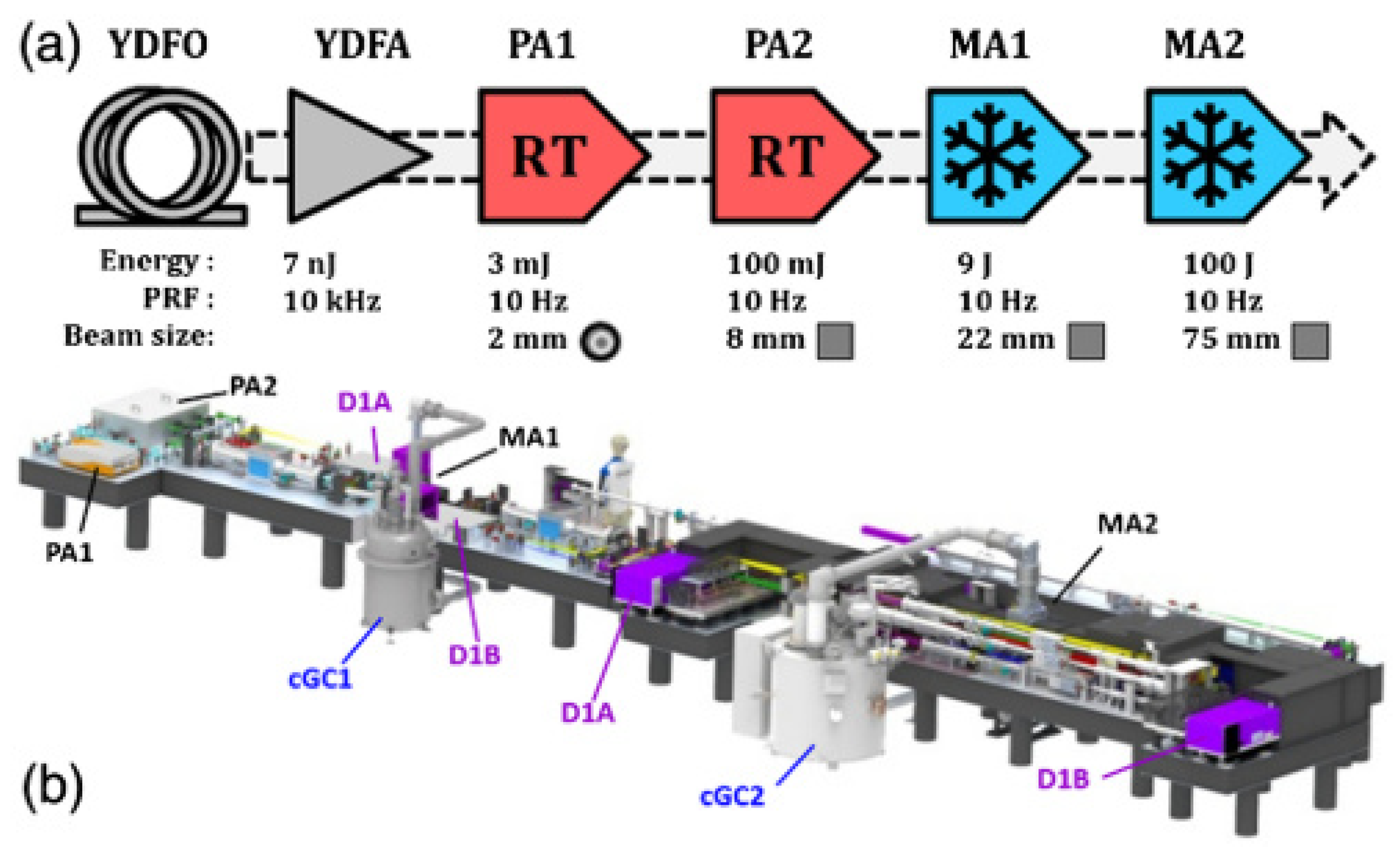

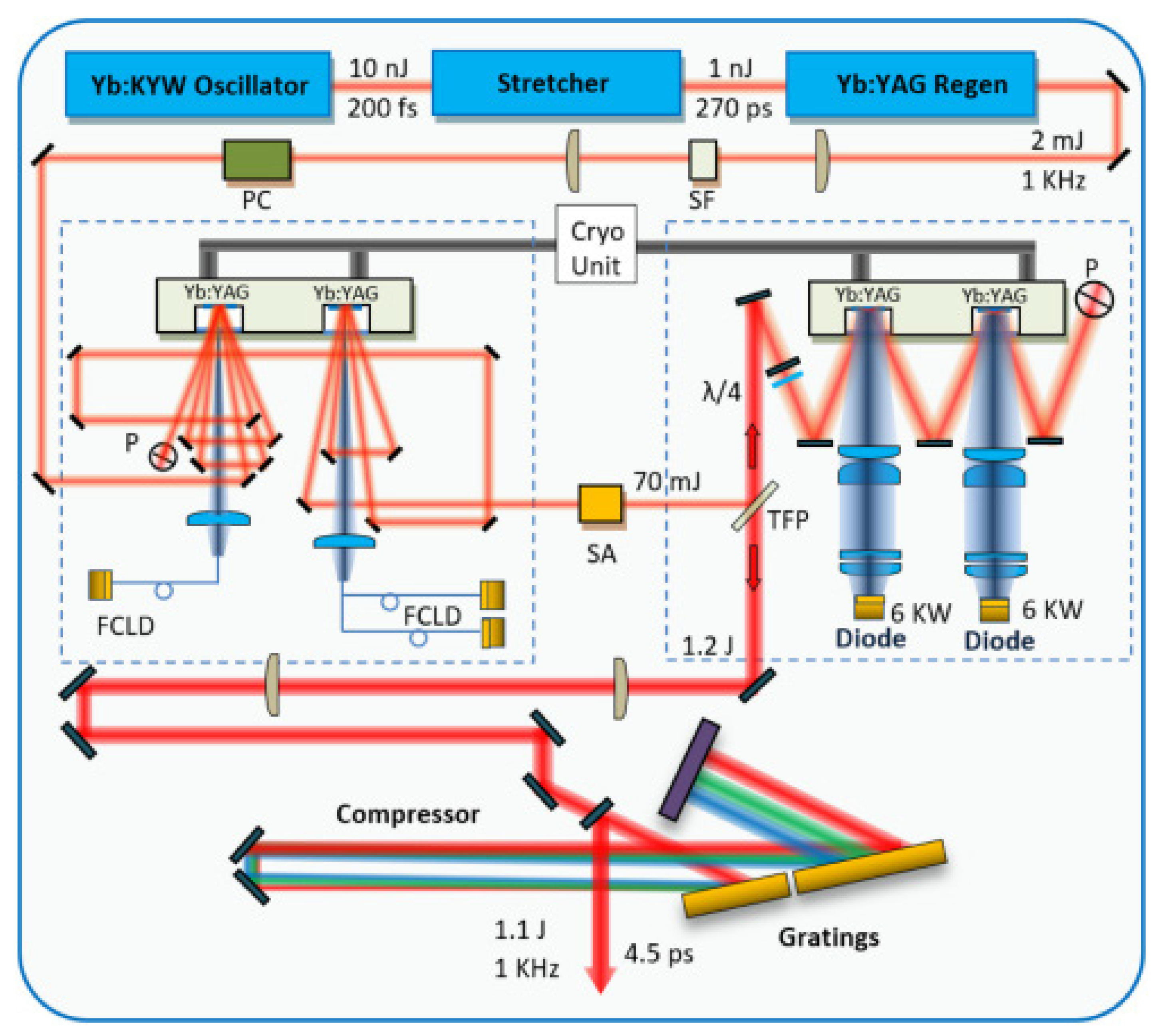
Publisher’s Note: MDPI stays neutral with regard to jurisdictional claims in published maps and institutional affiliations. |
© 2022 by the authors. Licensee MDPI, Basel, Switzerland. This article is an open access article distributed under the terms and conditions of the Creative Commons Attribution (CC BY) license (https://creativecommons.org/licenses/by/4.0/).
Share and Cite
Sui, Y.; Yuan, M.; Bai, Z.; Fan, Z. Recent Development of High-Energy Short-Pulse Lasers with Cryogenically Cooled Yb:YAG. Appl. Sci. 2022, 12, 3711. https://doi.org/10.3390/app12083711
Sui Y, Yuan M, Bai Z, Fan Z. Recent Development of High-Energy Short-Pulse Lasers with Cryogenically Cooled Yb:YAG. Applied Sciences. 2022; 12(8):3711. https://doi.org/10.3390/app12083711
Chicago/Turabian StyleSui, Yuan, Mingheng Yuan, Zhenao Bai, and Zhongwei Fan. 2022. "Recent Development of High-Energy Short-Pulse Lasers with Cryogenically Cooled Yb:YAG" Applied Sciences 12, no. 8: 3711. https://doi.org/10.3390/app12083711
APA StyleSui, Y., Yuan, M., Bai, Z., & Fan, Z. (2022). Recent Development of High-Energy Short-Pulse Lasers with Cryogenically Cooled Yb:YAG. Applied Sciences, 12(8), 3711. https://doi.org/10.3390/app12083711




